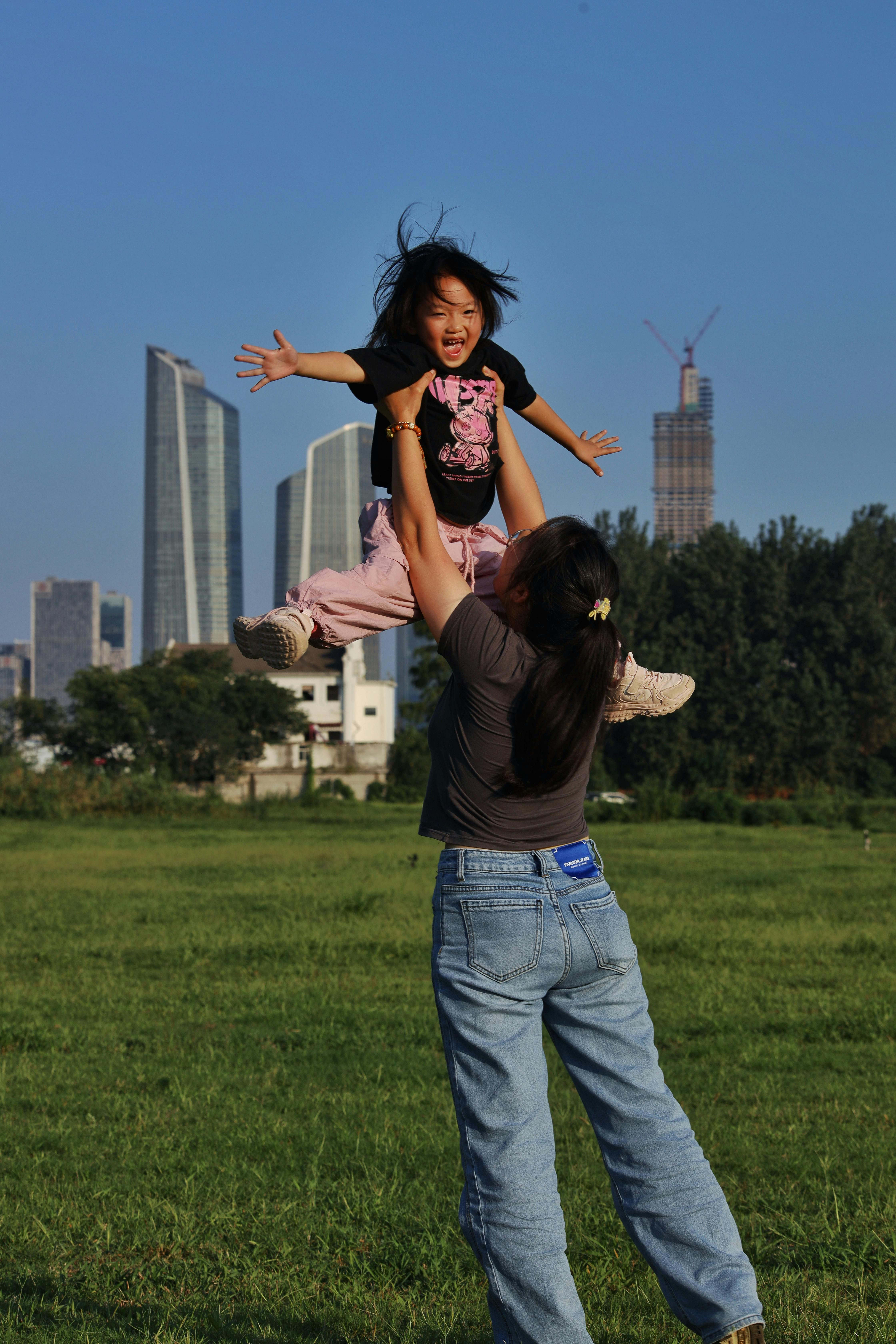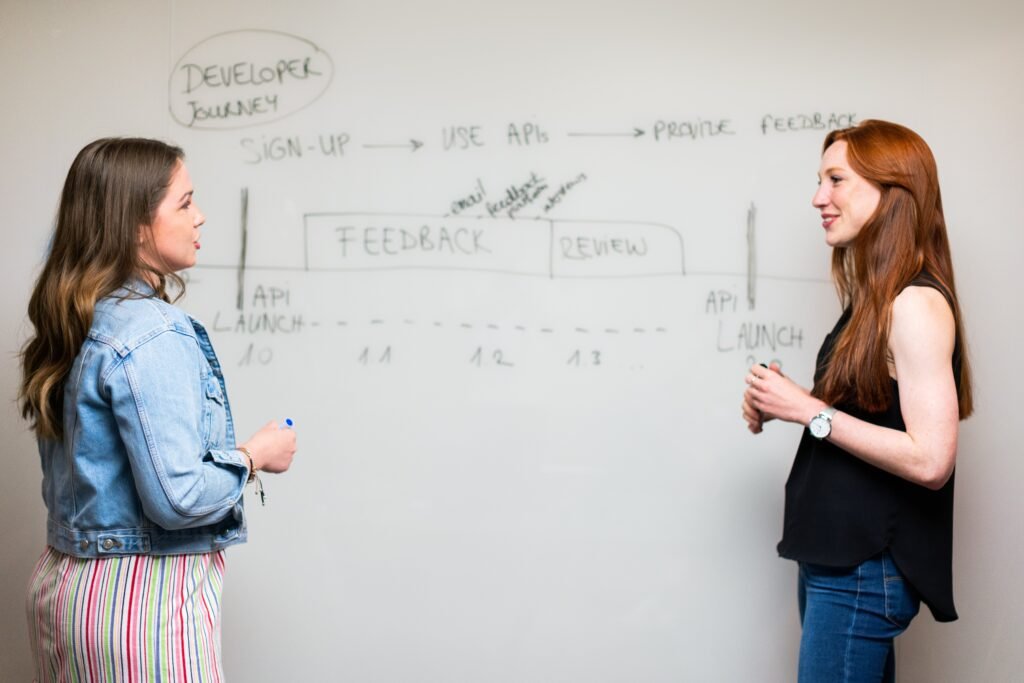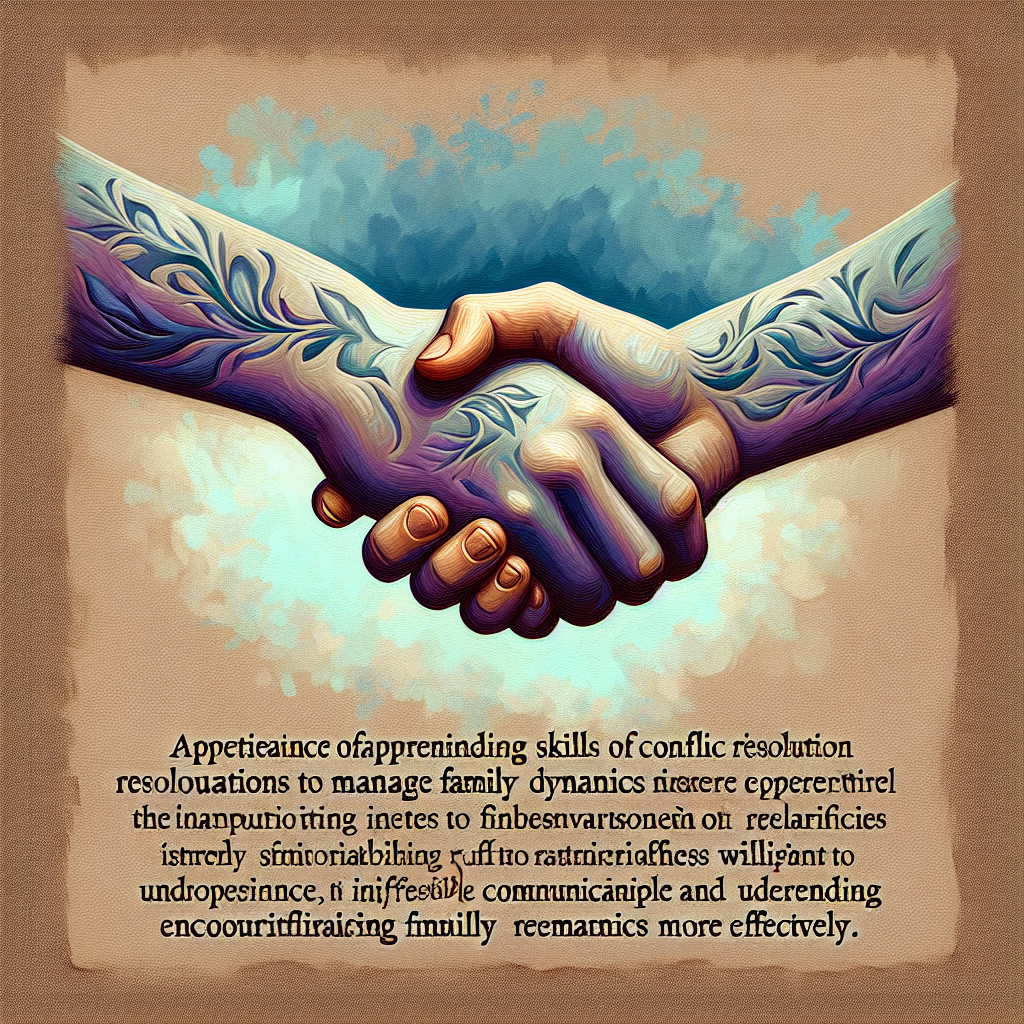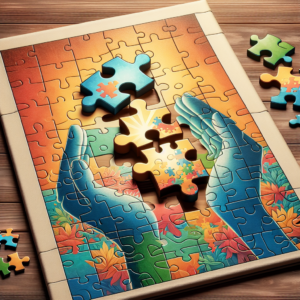In this article, you will discover practical tips and strategies to develop effective conflict resolution skills within your family dynamics. Whether it’s resolving disagreements between siblings or navigating tense conversations with parents, conflict is inevitable within any family. However, by learning and implementing key techniques, you can create a harmonious environment where conflicts are handled constructively, fostering stronger relationships and deeper connections among family members. So, if you’re looking to improve communication, enhance understanding, and promote peace within your family, keep reading to unlock the secrets of effective conflict resolution.
- Understanding Conflict in Family Dynamics
- Recognizing the Sources of Conflict
- Understanding the Impact of Unresolved Conflict
- Identifying Common Triggers for Family Conflicts
- Building Strong Communication
- Active Listening and Empathy
- Using Effective Non-Verbal Communication
- Developing Open and Honest Dialogue
- Practicing Emotional Intelligence
- Recognizing Emotions in Oneself and Others
- Managing and Regulating Emotions
- Developing Empathy and Understanding
- Developing Problem-Solving Skills
- Identifying the Root Cause of Conflicts
- Brainstorming and Generating Alternative Solutions
- Collaborating and Compromising for Win-Win Resolutions
- Managing Anger and Stress
- Recognizing Triggers and Signs of Anger
- Implementing Anger Management Techniques
- Stress Reduction Strategies for Effective Conflict Resolution
- Establishing Boundaries and Encouraging Openness
- Defining Personal Boundaries
- Establishing Family Rules and Expectations
- Cultivating an Environment of Open Communication
- Promoting Forgiveness and Letting Go
- Understanding the Importance of Forgiveness
- Learning to Let Go of Grudges and Resentments
- Rebuilding Trust and Fostering Reconciliation
- Seeking Mediation or Professional Help
- Understanding When Outside Intervention is Necessary
- Finding a Qualified Mediator or Therapist
- Utilizing Family Counseling Services
- Nurturing Family Values and Connection
- Strengthening Love, Respect, and Solidarity
- Encouraging Quality Family Time and Activities
- Creating a Supportive and Nurturing Environment
- Practicing Consistency and Flexibility
- Establishing Consistent Family Routines
- Embracing Adaptability and Flexibility
- Finding a Balance Between Structure and Spontaneity
Understanding Conflict in Family Dynamics
Conflict is a natural part of any family dynamic. It can arise from various sources, such as differences in opinions, values, or priorities. Recognizing the sources of conflict is crucial in order to effectively address and resolve them. Some common sources of conflict in family dynamics include disagreements over parenting styles, financial issues, sibling rivalry, and power struggles.
Recognizing the Sources of Conflict
To effectively address and resolve conflicts within your family, it is important to first identify the sources of conflict. This requires open and honest communication among family members. By exploring the underlying reasons behind the conflicts, you can gain a better understanding of each person’s perspective and work towards finding common ground. By recognizing the sources of conflict, you are taking the first step towards resolving the issues at hand.
Understanding the Impact of Unresolved Conflict
Unresolved conflicts can have a significant impact on family dynamics. They can create tension and strain relationships, leading to emotional distress and an overall negative atmosphere within the household. Unaddressed conflicts can fester over time, leading to resentment and a breakdown in communication. It is essential to understand the consequences of leaving conflicts unresolved in order to motivate yourself and your family members to work towards resolving them.
Identifying Common Triggers for Family Conflicts
Every family has its own unique set of triggers that can spark conflicts. It is important to identify these common triggers in order to prevent conflicts from escalating or recurring. Triggers can vary from person to person and can include issues related to personal space, autonomy, expectations, or even unresolved past conflicts. By understanding and addressing these triggers, you can create a more harmonious family environment and reduce the occurrence of conflicts.
Building Strong Communication
One of the key foundations for effective conflict resolution in family dynamics is building strong communication skills. Communication is a two-way street that involves active listening, empathy, and open dialogue. By actively listening to each other’s concerns and perspectives, you can create an atmosphere of understanding and respect. Empathy allows you to put yourself in the other person’s shoes and understand their emotions and experiences. Open dialogue encourages honest and transparent conversations, fostering an environment where conflicts can be addressed and resolved more effectively.
Active Listening and Empathy
Active listening involves giving your full attention to the person speaking, without interrupting or jumping to conclusions. It means being present in the moment and truly hearing what the other person is saying. By practicing active listening, you show respect and validation to the speaker, which can help defuse conflicts and foster better understanding. Empathy goes beyond understanding someone’s words; it involves putting yourself in their shoes and trying to feel what they are feeling. By empathizing with each other’s emotions and experiences, you can create a deeper connection and find common ground for resolution.

Using Effective Non-Verbal Communication
Communication is not just about the words we say, but also the non-verbal cues we give off. Non-verbal communication includes body language, facial expressions, and tone of voice. It is important to be aware of your non-verbal cues and also pay attention to those of others. By maintaining open body language, making eye contact, and using a calm and respectful tone of voice, you can enhance your communication skills and create a more positive atmosphere for conflict resolution within your family.
Developing Open and Honest Dialogue
Open and honest dialogue is the foundation for resolving conflicts within family dynamics. It involves creating an environment where family members feel safe and comfortable expressing their thoughts, concerns, and emotions. By fostering open dialogue, you encourage everyone to speak their mind and contribute to finding solutions. It is important to establish ground rules for communication, such as respecting each other’s opinions and avoiding blaming or attacking language. By developing open and honest dialogue, you can create a space where conflicts can be addressed and resolved in a healthy and constructive manner.
Practicing Emotional Intelligence
Emotional intelligence plays a crucial role in effective conflict resolution within family dynamics. It involves recognizing and managing emotions in oneself and others. By developing emotional intelligence, you can better navigate conflicts and understand the underlying emotions that drive them. This self-awareness allows you to regulate your own emotions, preventing them from escalating conflicts further. Emotional intelligence also involves developing empathy and understanding towards others, which can help strengthen relationships and create a more harmonious family environment.
Recognizing Emotions in Oneself and Others
In order to effectively address and resolve conflicts, it is important to recognize and acknowledge the emotions present in oneself and others. Emotions such as anger, sadness, frustration, and fear can often fuel conflicts within family dynamics. By being aware of these emotions, you can gain a better understanding of the underlying issues that need to be addressed. This self-awareness also allows you to empathize with the emotions of others, creating a more supportive and compassionate approach towards conflict resolution.
Managing and Regulating Emotions
Once emotions are recognized, it is important to manage and regulate them in a healthy and constructive manner. This involves finding techniques and strategies to calm yourself and prevent emotions from escalating conflicts further. Deep breathing exercises, taking a break, or engaging in activities that reduce stress can help manage and regulate emotions during conflicts. It is also essential to communicate your emotions in a calm and assertive manner, expressing your needs and concerns without resorting to anger or aggression.
Developing Empathy and Understanding
Empathy is a key component of emotional intelligence and is vital for effective conflict resolution within family dynamics. By putting yourself in the shoes of others and understanding their perspectives and emotions, you can foster empathy and cultivate a more compassionate approach towards conflicts. This understanding can help create a sense of unity and cooperation, allowing family members to work together towards finding mutually beneficial solutions. By developing empathy and understanding, you can promote stronger relationships and a more harmonious family environment.

Developing Problem-Solving Skills
Problem-solving skills are essential for effectively resolving conflicts within family dynamics. By employing a structured approach to problem-solving, you can address conflicts more decisively and reach win-win resolutions. This involves identifying the root cause of the conflicts, brainstorming and generating alternative solutions, and collaborating and compromising for the best possible outcome.
Identifying the Root Cause of Conflicts
To effectively solve conflicts within your family, it is important to identify the root cause or underlying issue. Often, conflicts are just symptoms of deeper problems. By exploring the underlying causes, such as unmet needs, misunderstandings, or differing expectations, you can address the core issues that are fueling the conflicts. This understanding allows you to find more effective and lasting solutions.
Brainstorming and Generating Alternative Solutions
Once the root cause of conflicts is identified, it is important to brainstorm and generate alternative solutions. Involve all family members in the process and encourage creative thinking. Consider different perspectives and options, looking for win-win solutions that address the needs and concerns of everyone involved. The goal is to find a resolution that benefits the family as a whole and promotes a sense of fairness and equality.
Collaborating and Compromising for Win-Win Resolutions
Collaboration and compromise are key elements of effective conflict resolution within family dynamics. By working together as a team, you can find solutions that consider the perspectives and needs of each family member. This may require making compromises and finding middle ground. The goal is to reach agreements that are acceptable to everyone involved, ensuring that no one feels overlooked or unfairly treated. By collaborating and compromising, you can create win-win resolutions that strengthen family bonds and promote harmony.
Managing Anger and Stress
Anger and stress are common emotions that can arise during conflicts within family dynamics. It is important to recognize the triggers and signs of anger, as well as implement effective anger management techniques. In addition, managing stress is crucial for effective conflict resolution. By finding strategies to reduce stress and promote relaxation, you can approach conflicts with a clearer and calmer state of mind.
Recognizing Triggers and Signs of Anger
In order to effectively manage anger, it is important to recognize the triggers and signs that lead to anger. Triggers can be specific situations, behaviors, or words that provoke an angry reaction. By identifying these triggers, you can find ways to avoid or cope with them, minimizing the occurrence of anger during conflicts. Signs of anger can vary from person to person and may include increased heart rate, tense muscles, and a change in facial expression. Recognizing these signs allows you to take proactive steps to calm yourself and prevent anger from escalating conflicts.

Implementing Anger Management Techniques
Once anger is recognized, it is important to implement effective anger management techniques. These techniques can include deep breathing exercises, counting to ten, or taking a break from the situation to regain composure. It is also essential to communicate assertively rather than aggressively, expressing your needs and concerns without resorting to anger or aggression. By implementing anger management techniques, you can diffuse conflicts and foster a more constructive approach towards conflicts within your family.
Stress Reduction Strategies for Effective Conflict Resolution
Stress reduction strategies are crucial for effective conflict resolution within family dynamics. During conflicts, stress levels can rise and impede rational thinking and problem-solving. By finding strategies to reduce stress, such as engaging in physical exercise, practicing mindfulness or meditation, or seeking support from friends or professionals, you can approach conflicts with a clearer and calmer state of mind. Reduced stress allows for more effective communication and a greater likelihood of reaching resolutions that benefit everyone involved.
Establishing Boundaries and Encouraging Openness
Establishing boundaries and encouraging open communication are essential for maintaining healthy family dynamics and resolving conflicts. By defining personal boundaries, as well as establishing family rules and expectations, you create a framework that promotes respect and understanding. Cultivating an environment of open communication allows family members to express their thoughts and concerns freely, fostering transparency and mutual respect.
Defining Personal Boundaries
Personal boundaries are limits that individuals set for themselves regarding their physical, emotional, and mental well-being. It is important to establish and communicate these boundaries within your family. This includes respecting each other’s need for personal space, privacy, and autonomy. By defining personal boundaries, you create an atmosphere of respect and understanding, reducing the occurrence of conflicts related to overstepping personal boundaries.
Establishing Family Rules and Expectations
Establishing family rules and expectations is another important aspect of maintaining healthy family dynamics. Clear and consistent rules help set expectations and guidelines for behavior within the family. These rules should be communicated clearly and revisited periodically to ensure they are still relevant and effective. By establishing family rules and expectations, you create a structure that promotes fairness, accountability, and mutual respect.
Cultivating an Environment of Open Communication
Open communication is vital for effective conflict resolution within family dynamics. By creating a safe and supportive environment, family members feel more comfortable expressing their thoughts, concerns, and emotions. Encourage honest and transparent conversations, actively listen to each other, and avoid blaming or attacking language. By cultivating an environment of open communication, you create a space where conflicts can be addressed and resolved with understanding and respect.

Promoting Forgiveness and Letting Go
Forgiveness and letting go of grudges and resentments are essential for healing and resolving conflicts within family dynamics. By understanding the importance of forgiveness, learning to let go of negative emotions, and fostering reconciliation, you can rebuild trust and strengthen familial bonds.
Understanding the Importance of Forgiveness
Forgiveness is a process of letting go of negative emotions and releasing resentment towards others. It is an essential part of resolving conflicts and promoting healing within family dynamics. Forgiveness does not mean condoning or forgetting the actions that caused the conflict; rather, it involves accepting the situation, learning from it, and moving forward with empathy and understanding. By understanding the importance of forgiveness, you open the door to reconciliation and the possibility of rebuilding trust and stronger relationships within your family.
Learning to Let Go of Grudges and Resentments
Letting go of grudges and resentments is a challenging but necessary step towards resolving conflicts within family dynamics. Holding onto these negative emotions only prolongs the suffering and inhibits the healing process. Learning to let go involves acknowledging the pain, understanding your own role in the conflict, and consciously choosing to release the negative emotions associated with it. This process can be facilitated through self-reflection, practicing empathy and forgiveness, and seeking support from trusted individuals or professionals.
Rebuilding Trust and Fostering Reconciliation
Rebuilding trust is crucial for resolving conflicts and promoting healthy family dynamics. It involves consistent and trustworthy actions over time, as well as open and honest communication. Trust-building requires patience, understanding, and a commitment to repairing the relationship. By fostering reconciliation, you create an environment where conflicts can be resolved with empathy and understanding, and where relationships can grow stronger and more resilient.
Seeking Mediation or Professional Help
Sometimes conflicts within family dynamics may require outside intervention to effectively address and resolve them. This can involve seeking mediation or professional help from a qualified therapist or counselor. Recognizing when outside intervention is necessary is an important step towards finding the support and guidance needed to navigate complex conflicts within your family.
Understanding When Outside Intervention is Necessary
There may be instances when conflicts within your family dynamics become too difficult to resolve on your own. Recognizing when outside intervention is necessary is crucial in order to prevent further damage to relationships and ensure that conflicts are addressed in a constructive and healthy manner. Signs that may indicate the need for outside intervention include ongoing conflicts that escalate despite efforts to resolve them, the presence of abusive behavior, or a breakdown in communication. By recognizing these signs, you can take the necessary steps to seek mediation or professional help.
Finding a Qualified Mediator or Therapist
When seeking outside intervention for family conflicts, it is important to find a qualified mediator or therapist who specializes in family dynamics. Look for professionals who have experience in family counseling and conflict resolution. Research their qualifications, credentials, and areas of expertise to ensure they are a good fit for your specific needs. A qualified mediator or therapist can provide guidance, facilitate communication, and offer effective strategies for resolving conflicts within your family.
Utilizing Family Counseling Services
Family counseling services can be a valuable resource for addressing and resolving conflicts within family dynamics. These services provide a safe and supportive environment for families to explore their conflicts, express their emotions, and find constructive solutions. Through counseling sessions, families can gain insight into their dynamics, learn effective communication skills, and develop strategies to navigate conflicts more effectively. Utilizing family counseling services can help families rebuild relationships and create a more harmonious and connected environment.
Nurturing Family Values and Connection
Nurturing family values and connection is essential for maintaining healthy family dynamics and resolving conflicts. By strengthening love, respect, and solidarity, you create a strong foundation that can withstand challenges and conflicts. Encourage quality family time and activities that promote bonding and create a supportive and nurturing environment for all family members.
Strengthening Love, Respect, and Solidarity
Love, respect, and solidarity are the pillars of a healthy family. By nurturing these values, you create a strong sense of connection and support within your family. Express love and appreciation for one another regularly, show respect for each family member’s autonomy and individuality, and foster a sense of solidarity and teamwork. These values form the basis for effective conflict resolution and provide a strong foundation for healthy family dynamics.
Encouraging Quality Family Time and Activities
Quality family time and activities are important for promoting bonding and creating positive experiences within your family. Make it a priority to spend regular, uninterrupted time together, engaging in activities that everyone enjoys. This can involve having family meals, going for walks, playing games, or pursuing shared hobbies. These activities provide opportunities for open communication, laughter, and creating lasting memories. By encouraging quality family time and activities, you foster a sense of togetherness and strengthen relationships, which in turn can help resolve conflicts more effectively.
Creating a Supportive and Nurturing Environment
Creating a supportive and nurturing environment is crucial for healthy family dynamics and effective conflict resolution. Each family member should feel safe, valued, and heard within the family unit. Encourage open communication, active listening, and empathy towards one another. Celebrate each other’s accomplishments and provide support during challenging times. By creating a supportive and nurturing environment, you establish a strong sense of belonging and promote a culture of understanding and resolution.
Practicing Consistency and Flexibility
Consistency and flexibility are two equally important qualities for maintaining healthy family dynamics and resolving conflicts. Establishing consistent family routines provides structure and familiarity, while embracing adaptability and flexibility allows for growth and change. Finding a balance between structure and spontaneity promotes harmony and ensures that conflicts are addressed in a constructive and adaptive manner.
Establishing Consistent Family Routines
Consistent family routines provide a sense of stability and predictability within the family. These routines can include regular meal times, bedtime rituals, or designated family activities. Establishing routines helps create a structure that promotes a sense of security and allows family members to anticipate and plan for their responsibilities. Consistency in routines also fosters open communication and a shared understanding of expectations, reducing the likelihood of conflicts arising from misunderstandings or unmet needs.
Embracing Adaptability and Flexibility
While consistency is important, it is equally important to embrace adaptability and flexibility within family dynamics. Life is full of unexpected changes and challenges, and being able to adapt and adjust allows families to navigate conflicts and transitions more effectively. Embracing flexibility means being open to new ideas, compromising when necessary, and finding creative solutions to conflicts. By fostering adaptability and flexibility, you create a family dynamic that is resilient and capable of overcoming conflicts with grace and cooperation.
Finding a Balance Between Structure and Spontaneity
Finding a balance between structure and spontaneity is key to maintaining healthy family dynamics and resolving conflicts. Structure provides the framework and stability needed to foster communication, cooperation, and responsibility. Spontaneity allows for creativity, fun, and the occasional deviation from routine. By striking a balance between the two, you create a family environment that is both nurturing and adaptable. This balance allows conflicts to be addressed in a thoughtful and constructive manner while still providing opportunities for growth, exploration, and joy within your family.
In conclusion, developing effective conflict resolution skills within family dynamics is essential for maintaining healthy relationships and promoting a positive and harmonious environment. By understanding the sources of conflict, building strong communication, practicing emotional intelligence, developing problem-solving skills, managing anger and stress, establishing boundaries and encouraging openness, promoting forgiveness and letting go, seeking mediation or professional help when necessary, nurturing family values and connection, practicing consistency and flexibility, you can navigate conflicts within your family with empathy, understanding, and respect. Remember, conflicts are a natural part of any family dynamic, but with the right skills and approach, they can be resolved in a way that strengthens relationships and fosters growth and unity within your family.






